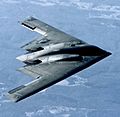Stealth aircraft facts for kids
Stealth aircraft are designed to avoid detection using a variety of technologies that reduce reflection/emission of radar, infrared, visible light, radio frequency (RF) spectrum, and audio, collectively known as stealth technology. F-117 Nighthawk is the first operational aircraft specifically designed around stealth technology. Other examples of stealth aircraft include the B-2 Spirit, the F-22 Raptor, the F-35 Lightning II, the Chengdu J-20, and the Sukhoi Su-57.
While no aircraft is totally invisible to radar, stealth aircraft make it more difficult for conventional radar to detect or track the aircraft effectively, increasing the odds of an aircraft successfully avoiding detection by enemy radar and/or avoiding being successfully targeted by radar guided weapons. Stealth is the combination of passive low observable (LO) features and active emitters such as low-probability-of-intercept radars, radios and laser designators. These are usually combined with active measures such as carefully planning all mission maneuvers in order to minimize the aircraft's radar cross-section, since common actions such as hard turns or opening bomb bay doors can more than double an otherwise stealthy aircraft's radar return. It is accomplished by using a complex design philosophy to reduce the ability of an opponent's sensors to detect, track, or attack the stealth aircraft. This philosophy also takes into account the heat, sound, and other emissions of the aircraft as these can also be used to locate it. Sensors made to reduce the impact of current low observable technologies exist or have been proposed such as IRST (infrared search and track) systems to detect even reduced heat emissions, long wavelength radars to counter stealth shaping and RAM focused on shorter wavelength radar, or radar setups with multiple emitters to counter stealth shaping. However these do so with disadvantages compared to traditional radar against non-stealthy aircraft.
Images for kids
-
B-2 Spirit stealth bomber of the U.S. Air Force
-
In a 1994 live fire exercise near Point Mugu, California, a U.S. Air Force B-2 Spirit dropped forty-seven 500 lb (230 kg) class Mark 82 bombs, which represents about half of a B-2's total ordnance payload in Block 30 configuration
See also
 In Spanish: Avión furtivo para niños
In Spanish: Avión furtivo para niños





